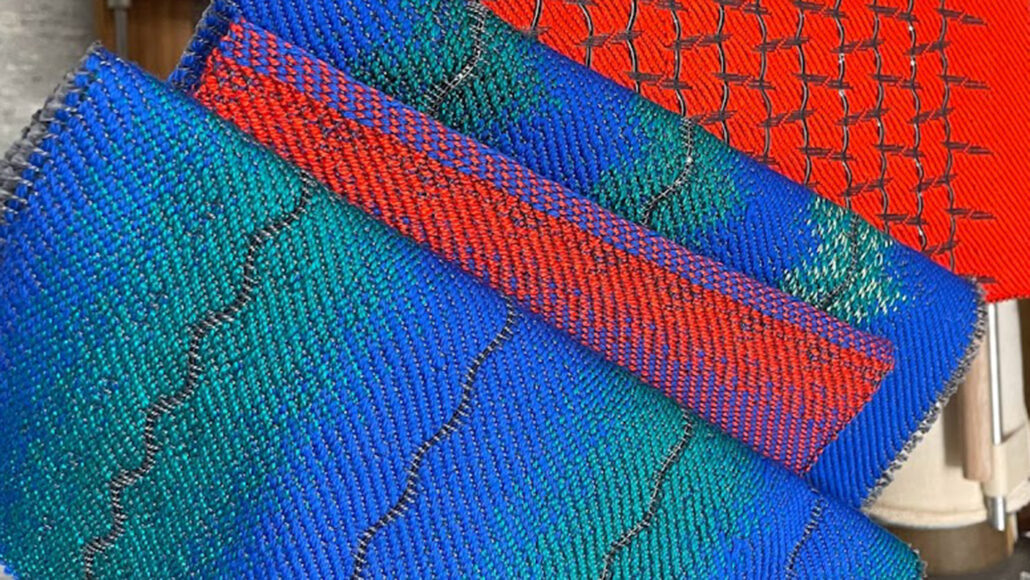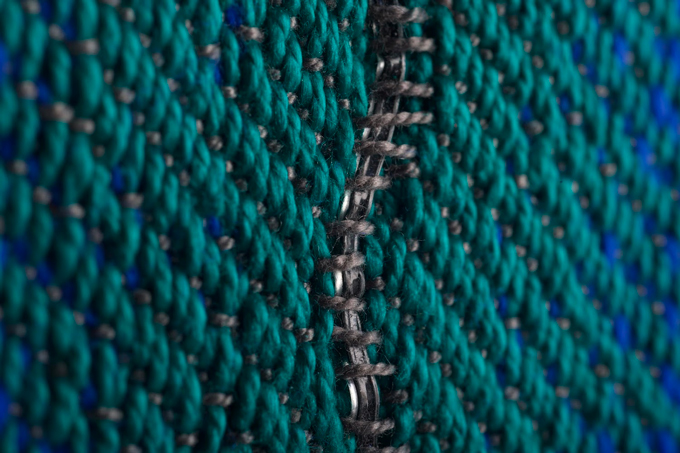This new fabric can ‘hear’ sounds or broadcast them
Inspired by the eardrum, this material converts sound to electrical signals

This new fabric can capture sounds from the environment. Able to hear sounds, such materials could provide a comfy — and perhaps trendy — way to monitor body functions or aid with hearing.
Fink Lab/MIT, Elizabeth Meiklejohn/RISD
Someday, our clothes may eavesdrop on the soundtrack of our lives.
A new fiber acts as a microphone. It can pick up speech, rustling leaves — even chirping birds. It then turns those acoustic signals into electrical ones. Woven into fabric, these fibers can hear handclaps and faint sounds. They can even catch the beating of its wearer’s heart, researchers report March 16 in Nature.
Fabrics containing these fibers might become an easy, comfy — and maybe trendy — way to listen to our organs or to aid hearing.
Cloth that interacts with sounds has existed for perhaps hundreds of years, says Wei Yan. He worked on the fabric while at the Massachusetts Institute of Technology, or MIT, in Cambridge. As a materials scientist, he uses physics and chemistry to investigate and design materials.
Fabrics have usually been used to muffle sound, notes Yan, who now works at Nanyang Technological University in Singapore. Using fabric instead as a microphone, he says, is “totally a different concept.”
Taking a beat from the eardrum
The new research was inspired by the human eardrum, Yan says. Sound waves cause the eardrum to vibrate. The ear’s cochlea (KOAK-lee-uh) converts those vibrations into electrical signals. “It turns out that this eardrum is made of fibers,” notes materials scientist Yoel Fink. He was part of the MIT team that spun up the new fabric.
Fibers in the eardrum’s inner layers crisscross. Some extend out from the eardrum’s center. Others form circles. Made of the protein collagen, those fibers help people hear. Their arrangement, Fink says, resembles the fabrics people weave.
Similar to what it does to the eardrum, sound vibrates fabric. The new fabric contains cotton fibers and others made of a stiff material called Twaron. That combination of threads helps turn the energy from sounds into vibrations. But the cloth also includes a special fiber. It contains a blend of piezoelectric materials. Such materials produce a voltage when pressed or bent. Tiny buckles and bends of the piezoelectric fiber create electrical signals. Those signals can be sent to a device that reads and records the voltage.
The fabric microphone works at a range of sound levels. It can sense the difference between a quiet library and heavy traffic, the team reports. The researchers are still working to use computer software to help detangle the sounds they want to hear from a backdrop of noise. When woven into clothing, the sound-sensing fabric feels like regular fabric, Yan says. In tests, it continued to work as a microphone even after going through the wash 10 times.

Piezoelectric materials have “huge potential” for applications, says Vijay Thakur. A materials scientist, he works at Scotland’s Rural College in Edinburgh and did not play a role in developing the new fabric.
People have explored piezoelectric materials to generate energy from vibrations. But those materials have been limited by the very small voltages they produce. The way the new special fibers are made overcomes this challenge, he says. Their outer layer is super stretchy and flexible. It doesn’t take much energy to bend them. That concentrates the energy from vibrations into the piezoelectric layer. This makes the microphone more sensitive, says Thakur, who was not involved in the research.
High-tech threads
As a proof of concept, the team wove their fabric microphone into a shirt. Like a stethoscope, it could hear its wearer’s heartbeat. “This is really inspiring,” says Yogendra Mishra, who also was not involved in the new work. A materials engineer, he works at the University of Southern Denmark in Sønderborg. With a fiber mounted near the heart, this shirt could reliably measure someone’s heart rate.
It also could hear sound signatures of certain heart valves closing, the authors report. Used this way, the fabric microphone might listen for murmurs. Those are unusual sounds that can point to something wrong with how the heart is working.
Thakur says the fabric may someday be able to provide similar information as an echocardiogram (Ek-oh-KAR-dee-oh-gram). Such sensors use sound waves to image the heart. If shown to work for monitoring the body and for diagnosing disease, listening fabrics might find use in the clothes of young kids. Such apparel could make it easier to track heart conditions in little ones who have trouble staying still, he says.
The team also anticipates that the fabric microphone could help people who have trouble hearing. It might both amplify sound and help people detect a sound’s direction. To test this, Yan and his colleagues made a shirt with two sound-sensing fibers on its back. These fibers could detect the direction a clap came from. Because the two fibers were spaced apart, there was a small difference in when each picked up the sound.
And when hooked up to a power source, fabric made with the new fibers can even broadcast sound, acting as a speaker. Voltage signals sent to the fabric cause vibrations that make audible sounds.
“For the past 20 years, we’ve been trying to introduce a new way of thinking about fabrics,” says Fink at MIT. Fabrics have long provided beauty and warmth, but they can do more. They may help solve some acoustic problems. And perhaps, Fink says, they can beautify technology too.
This is one in a series presenting news on technology and innovation, made possible with generous support from the Lemelson Foundation.







